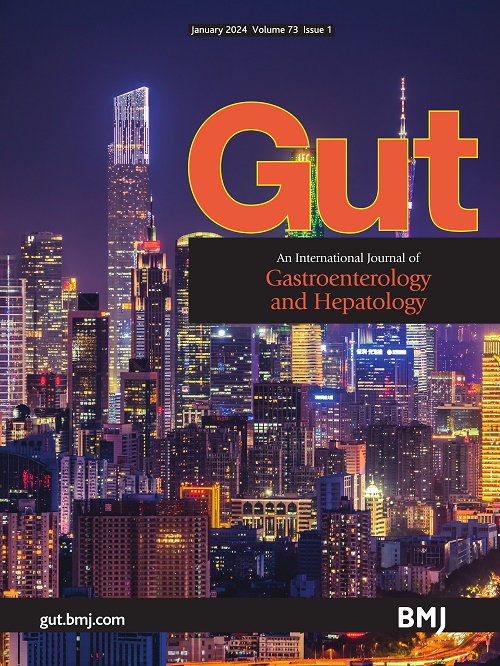FODMAPs和功能性消化不良:新出现的证据但未解决的问题
IF 25.8
1区 医学
Q1 GASTROENTEROLOGY & HEPATOLOGY
引用次数: 0
摘要
功能性消化不良(FD)是一种常见的肠脑相互作用(DGBI)疾病,其特征是胃脘痛或灼烧症状,称为胃脘痛综合征,以及令人烦恼的餐后饱腹或早饱,称为餐后窘迫综合征(PDS)当然,通俗地说,这些症状被患者描述为“消化不良”,考虑到它们与饮食有关的性质,通常将症状归因于食物可能不足为奇。事实上,患有消化不良的患者通常会优先确定其症状的饮食诱因。例如,避免饮酒以及辛辣或高脂肪食物的建议很常见。然而,这是基于很少的证据,并且很少有研究排除饮食在FD。相反,在肠易激综合征(IBS)中,另一种DGBI经常与FD重叠,广泛使用低可发酵低聚糖、双糖、单糖和多元醇(FODMAPs)的饮食FODMAPs是短链碳水化合物,在小肠中消化或吸收不良,导致渗透效应。FODMAPs也会被结肠细菌发酵。因此,限制FODMAP的摄入可以改善IBS患者的腹痛、腹泻和腹胀。在Gut杂志上,Van den Houte等人评估了低FODMAP饮食(LFD)对FD患者的治疗效果,包括采用盲法重新引入FODMAP粉剂来评估症状复发鉴于上述与小肠和结肠相关的IBS的作用机制,LFD可能不是一个明显的选择……本文章由计算机程序翻译,如有差异,请以英文原文为准。
FODMAPs and functional dyspepsia: emerging evidence but unanswered questions
Functional dyspepsia (FD) is a common disorder of gut-brain interaction (DGBI) characterised by symptoms of epigastric pain or burning, referred to as epigastric pain syndrome, and bothersome postprandial fullness or early satiation, referred to as postprandial distress syndrome (PDS).1 Colloquially, of course, such symptoms are described by patients as ‘indigestion’ and, given their meal-related nature, it is perhaps unsurprising that symptoms are often attributed to food. Indeed, patients with dyspepsia often prioritise identifying dietary triggers for their symptoms. Advice to avoid alcohol, as well as spicy or fatty foods, for example, is common. However, this is based on little evidence, and there are few studies of exclusion diets in FD. Conversely, in irritable bowel syndrome (IBS), another DGBI that frequently overlaps with FD, a diet low in fermentable oligosaccharides, disaccharides, monosaccharides and polyols (FODMAPs) is widely used.2 FODMAPs are short-chain carbohydrates that are poorly digested or absorbed in the small intestine, leading to osmotic effects. FODMAPs also undergo fermentation by colonic bacteria. Hence, restricting FODMAP intake can improve abdominal pain, diarrhoea and bloating in IBS. In Gut , Van den Houte et al have evaluated a low FODMAP diet (LFD) for treating patients with FD, including assessing symptom recurrence using blinded reintroduction of FODMAPs administered as powders.3 Given the mechanisms of action described above for IBS related to the small intestine and colon, an LFD might not be an obvious choice for …
求助全文
通过发布文献求助,成功后即可免费获取论文全文。
去求助
来源期刊

Gut
医学-胃肠肝病学
CiteScore
45.70
自引率
2.40%
发文量
284
审稿时长
1.5 months
期刊介绍:
Gut is a renowned international journal specializing in gastroenterology and hepatology, known for its high-quality clinical research covering the alimentary tract, liver, biliary tree, and pancreas. It offers authoritative and current coverage across all aspects of gastroenterology and hepatology, featuring articles on emerging disease mechanisms and innovative diagnostic and therapeutic approaches authored by leading experts.
As the flagship journal of BMJ's gastroenterology portfolio, Gut is accompanied by two companion journals: Frontline Gastroenterology, focusing on education and practice-oriented papers, and BMJ Open Gastroenterology for open access original research.
 求助内容:
求助内容: 应助结果提醒方式:
应助结果提醒方式:


